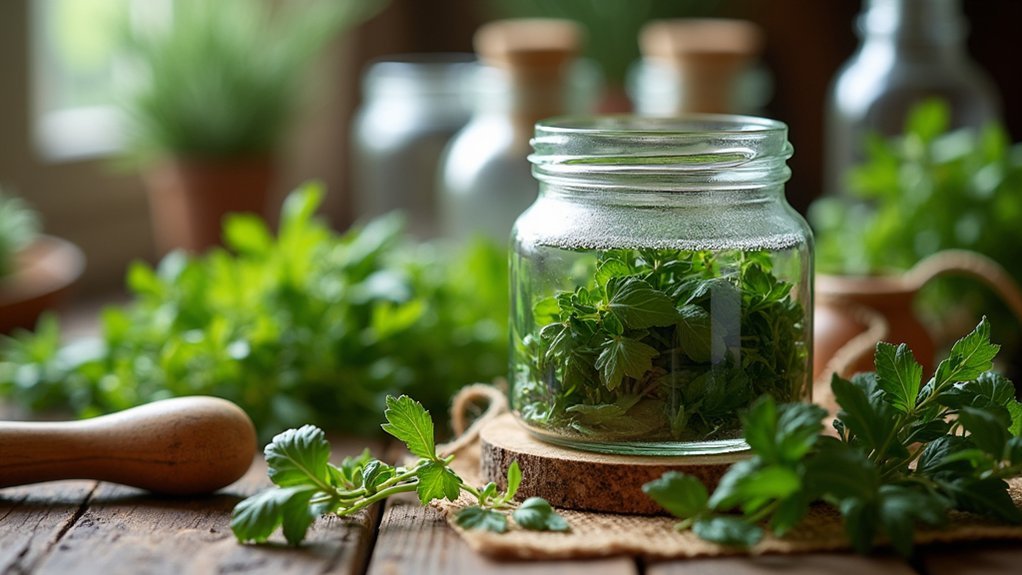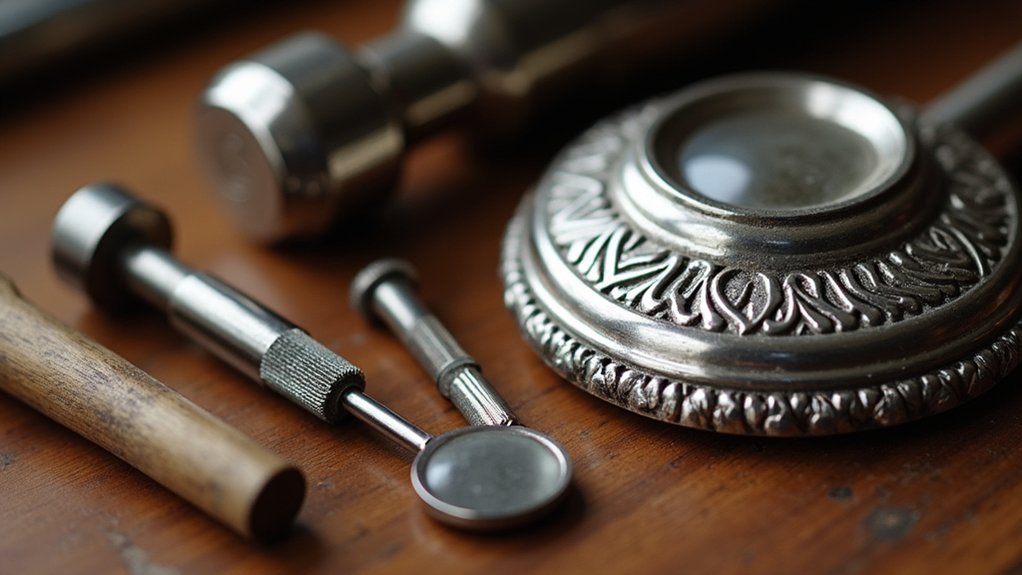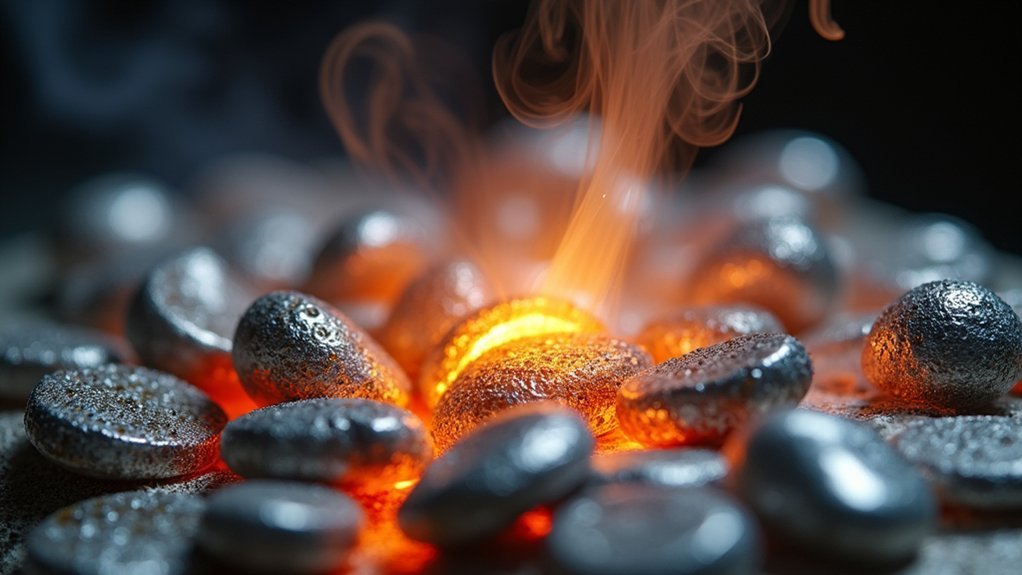You’ll need to master five essential wet packing enamel methods as a beginner. Start with basic single-color wet packing by cleaning copper thoroughly and building thin layers gradually. Try two-color wet packing for seamless shifts by blending edges with a spatula. Use transparent enamels for gradient effects through successive firings. Apply controlled techniques with paste consistency for detailed designs. Finally, create dimensional effects by layering wet enamel coats. These foundational techniques will reveal advanced enameling possibilities.
Basic Wet Packing With Single Color Enamel

When you’re starting with wet packing techniques, single color enamel offers the perfect foundation to master this essential skill.
Begin with proper metal preparation by cleaning your copper thoroughly. Wet your enamel powder with water until it reaches paste-like consistency. Use a small wire or spatula to scoop the mixture and place it centrally in your designated area.
Build up each layer of enamel gradually rather than overfilling initially. Transparent colors work exceptionally well for beginners since they’re forgiving and showcase the metal underneath beautifully.
Push and shape the wet enamel carefully, checking for stray grains before firing. Fire at appropriate firing temperature until the enamel surface becomes glossy.
You’ll likely need to apply a coat through subsequent firings to achieve desired thickness and smoothness.
Two-Color Wet Packing for Color Transitions
Once you’ve mastered single-color applications, two-color wet packing opens exciting possibilities for creating smooth color shifts and gradients on your metal surface. This technique involves applying two different enamel colors simultaneously in a single layer.
Start by wetting both powders and placing them side by side, then gently blend their edges with a spatula for seamless changes.
Wet both enamel powders, position side by side, and blend edges with a spatula for smooth color transitions.
Keep both colors wetter for effective merging, or apply them drier for controlled separation. Whether using transparent enamel or opaque enamel, the glass to metal bond remains consistent.
Layering thin coats between firings enhances depth and vibrancy in your enamel design. Experimenting with ratios and placement creates unique effects. Each piece becomes distinct through your creative approach to color changes.
Gradient Techniques Using Transparent Enamels

How can you achieve stunning gradient effects that flow like liquid color across your metal surface? Start by wet packing a base layer of transparent enamels, then gradually introduce your second color.
You’ll want to experiment with different ratios to control opacity and color intensity throughout your design.
Use a small sifter to apply contrasting colors, tilting your piece slightly so the enamels flow together naturally during application.
Once you’ve positioned your colors, mist the piece lightly with water to help granules settle and blend smoothly.
Don’t rush the process—build up multiple thin layers of enamel through successive firings.
This technique creates remarkable depth and richness in your gradient, transforming simple color shifts into sophisticated, professional-looking effects.
Controlled Application for Detailed Designs
While gradient techniques showcase enamel’s flowing beauty, detailed designs demand precision that only controlled wet packing can provide. You’ll mix enamel powder with water to create a paste-like consistency that’s perfect for controlled application on your metal surface.
| Step | Tool | Purpose |
|---|---|---|
| Mix | Spatula | Create paste consistency |
| Place | Pick | Center enamel in area |
| Shape | Spatula | Apply pressure evenly |
| Build | Multiple tools | Building up layers |
| Clean | Pick | Remove excess material |
Use your spatula to scoop wet enamel into detailed designs, applying gentle pressure to spread it evenly. Focus on building up layers rather than thick applications. Always inspect piece carefully before firing, ensuring you remove excess enamel that could compromise your final design.
Layered Wet Packing for Dimensional Effects

Building dimensional effects requires strategic layering that transforms flat enamel surfaces into sculptural masterpieces.
Layered wet packing allows you to apply enamel in controlled stages, creating depth that makes any metal can be enameled into stunning three-dimensional artwork.
Start with your base coat of enamel, ensuring cleaned surfaces for ideal adhesion. Each subsequent layer builds upon the previous one, allowing you to manipulate both transparent and opaque effects.
- Use a spatula to shape wet enamel, keeping layers even while avoiding overfills.
- Experiment with different consistencies—wetter mixtures fill corners better than dry enamel particles.
- Allow each layer to dry completely before adding the next to prevent unwanted mixing.
- Fire the piece after proper drying, then inspect for oxidation before continuing layering effects.
Frequently Asked Questions
Can You Enamel Without a Kiln?
Yes, you can enamel without a kiln using a torch. You’ll need a propane or butane torch, clean prepared metal, and steady technique to maintain consistent distance for even heating and proper enamel fusion.
Which of the Enameling Techniques Is the Most Difficult?
You’ll find cloisonné most challenging since you must precisely form and place fine metal wires to create individual cells. The technique demands exceptional skill in both metalwork and enamel application with minimal error margins.
What Is Russian Enamel Technique?
You’ll create intricate designs using fine wire compartments filled with transparent enamel powders. This Russian cloisonné technique requires multiple firings on precious metals, producing vibrant colors with visible underlying metalwork and wire structures.
What Are the Methods of Enamel Application?
You can apply enamel through wet packing by mixing powders with water, dry sifting for even coverage, or dusting dry powder directly onto heated metal surfaces for different artistic effects.
In Summary
You’ve now mastered five essential wet packing techniques that’ll transform your enameling practice. Start with single-color applications to build confidence, then progress through color shifts and gradients. Don’t rush the process—controlled application and layered techniques require patience but deliver stunning results. Practice each method regularly, and you’ll develop the muscle memory needed for consistent, professional-looking pieces. These foundational skills will support all your future enameling adventures.





Leave a Reply